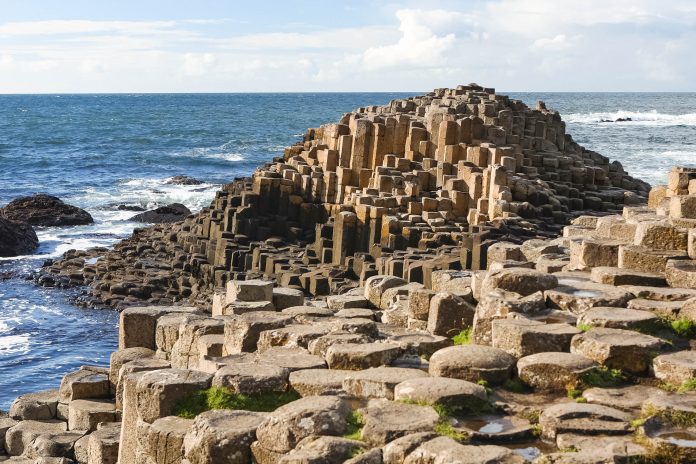Der Giant’s Causeway an der Nordküste Nordirlands beeindruckt durch seine atemberaubend symmetrischen Steinpfeiler, die auf völlig natürlichem Weg durch vulkanische Aktivität entstanden sind.
Der Giant’s Causeway („Damm des Riesen“) liegt in Nordirland an der Nordküste der Grafschaft Antrim ca. 80 Kilometer von Belfast entfernt. Das einzigartige Naturphänomen wird von den Iren als Achtes Weltwunder bezeichnet und steht auf unserer Liste der Top 10 Sehenswürdigkeiten von Großbritannien. Auch unter unseren Top 10 Sehenswürdigkeiten von Irland findet er Erwähnung. Seit 1986 zählt der Giant’s Causeway als erste Stätte auf der irischen Insel zum Weltnaturerbe der UNESCO.
Der Giant’s Causeway ist eine atemberaubende Laune der Natur, die vor etwa 60 Millionen Jahren entstanden ist. Auf einer Länge von 5 Kilometern erstrecken sich an die 40.000 absolut gleichmäßig geformte Basaltsäulen an der Küste Nordirlands bis ins Meer hinein. Wer diese Säulen sieht, glaubt zuerst nicht, dass die Natur diese spektakuläre Struktur ohne menschliches Zutun entstehen ließ.
Wie Bauklötze stehen die vier- bis achteckigen Pfeiler nebeneinander, ihre Oberfläche misst ungefähr 30cm. Manche von ihnen sind bis zu 12m hoch und die gesamte Gesteinsschicht ist bis zu 25m dick. Ständig von den Wellen des Meeres umspült bietet dieses Zeugnis aus prähistorischer Zeit einen wahrlich unvergesslichen Anblick. Der Giant’s Causeway hat sich mittlerweile zu einer der meist besuchten Sehenswürdigkeiten Nordirlands entwickelt.
Legende: Der Damm von Fionn mac Cumhaill
Laut einer irischen Sage wurde der Giant’s Causeway vom Riesen Fionn mac Cumhaill errichtet. Nachdem er von seinem schottischen Widersacher Benandonner beleidigt worden war, beschloss er, einen Weg über das Meer ins benachbarte Schottland zu bauen, um seinen Feind zum Kampf herauszufordern. Benandonner wollte sein Gesicht nicht verlieren und folgte dem Ruf Fionn mac Curhills nach Irland. Der irische Riese war jedoch vom Dammbau so erschöpft, dass er Benandonner mit einer Liste hinhalten musste. Als Baby verkleidet trug er seiner Frau auf, Benandonner zu sagen, dass er bald hier sein werde. Doch als Benandonner das riesenhafte Baby sah und er sich dann auch noch die unglaubliche Größe des Vaters vorstellte, verließ ihn der Mut. Hals über Kopf floh er zurück nach Schottland und zerstörte den Damm hinter sich, sodass ihm der schreckliche Fionn nie wieder würde folgen können. Und tatsächlich findet man auch auf der Hebrideninsel Staffa vor der Küste Schottlands ein ganz ähnliches steinernes Phänomen.
Entdeckung des Giant’s Causeway
Als der Giant’s Causeway im Jahr 1693 von einem Studenten des Trinity-Colleges in Dublin erstmals der Royal Society präsentiert wurde, war das Staunen groß. Zeichner wurden vor Ort geschickt, um dieses einzigartige Phänomen bildlich festzuhalten und Streitigkeiten kamen auf, ob diese Strukturen nicht doch von Menschen oder einem Riesen oder tatsächlich von der Natur geschaffen wurden. 1771 erklärte ein französischer Wissenschaftler den tatsächlichen Ursprung der imposanten Säulen als vulkanische Aktivität.
Tatsächlich entstanden die symmetrischen Steine aus flüssiger Lava, die sehr langsam und gleichmäßig abkühlte und so die senkrechten Flächen bildete. Dabei haben sich bizarre Formen herauskristallisiert, die bezeichnende Namen wie „Hufeisen“, „Riesenorgel“ oder „Fächer“ tragen. Die eindrucksvollste Skulptur ist das Amphitheater, deren gewaltige Klötze an die Sitze eines antiken Rundtheaters erinnern. Der Vulkan, der die spektakulären Säulen einst entstehen ließ, ist mittlerweile nicht mehr vorhanden.
Im Besucherzentrum gibt es kostenpflichtige Parkplätze, Verpflegungsmöglichkeiten, Kartenmaterial und Audioguides. Wer nur den Giant’s Causeway selbst besichtigen möchte, ohne die touristischen Einrichtungen zu nutzen (auch keinen Parkplatz!) braucht nichts zu bezahlen.
Weiterführende Links:
Öffnungszeiten und Eintrittspreise des Giant’s Causeway





